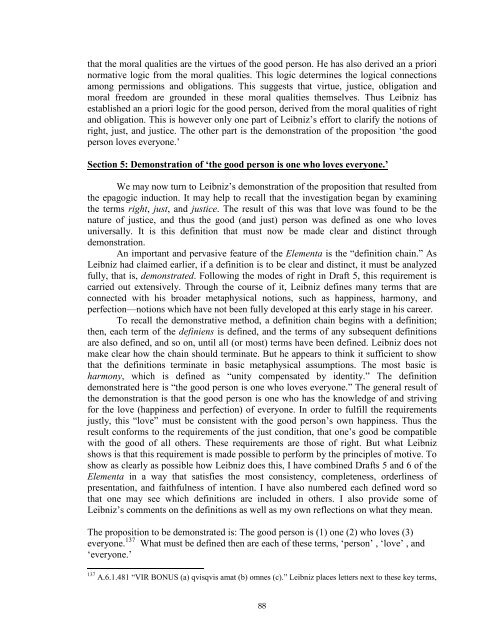Stony Brook University
Stony Brook University
Stony Brook University
You also want an ePaper? Increase the reach of your titles
YUMPU automatically turns print PDFs into web optimized ePapers that Google loves.
that the moral qualities are the virtues of the good person. He has also derived an a priori<br />
normative logic from the moral qualities. This logic determines the logical connections<br />
among permissions and obligations. This suggests that virtue, justice, obligation and<br />
moral freedom are grounded in these moral qualities themselves. Thus Leibniz has<br />
established an a priori logic for the good person, derived from the moral qualities of right<br />
and obligation. This is however only one part of Leibniz’s effort to clarify the notions of<br />
right, just, and justice. The other part is the demonstration of the proposition ‘the good<br />
person loves everyone.’<br />
Section 5: Demonstration of ‘the good person is one who loves everyone.’<br />
We may now turn to Leibniz’s demonstration of the proposition that resulted from<br />
the epagogic induction. It may help to recall that the investigation began by examining<br />
the terms right, just, and justice. The result of this was that love was found to be the<br />
nature of justice, and thus the good (and just) person was defined as one who loves<br />
universally. It is this definition that must now be made clear and distinct through<br />
demonstration.<br />
An important and pervasive feature of the Elementa is the “definition chain.” As<br />
Leibniz had claimed earlier, if a definition is to be clear and distinct, it must be analyzed<br />
fully, that is, demonstrated. Following the modes of right in Draft 5, this requirement is<br />
carried out extensively. Through the course of it, Leibniz defines many terms that are<br />
connected with his broader metaphysical notions, such as happiness, harmony, and<br />
perfection—notions which have not been fully developed at this early stage in his career.<br />
To recall the demonstrative method, a definition chain begins with a definition;<br />
then, each term of the definiens is defined, and the terms of any subsequent definitions<br />
are also defined, and so on, until all (or most) terms have been defined. Leibniz does not<br />
make clear how the chain should terminate. But he appears to think it sufficient to show<br />
that the definitions terminate in basic metaphysical assumptions. The most basic is<br />
harmony, which is defined as “unity compensated by identity.” The definition<br />
demonstrated here is “the good person is one who loves everyone.” The general result of<br />
the demonstration is that the good person is one who has the knowledge of and striving<br />
for the love (happiness and perfection) of everyone. In order to fulfill the requirements<br />
justly, this “love” must be consistent with the good person’s own happiness. Thus the<br />
result conforms to the requirements of the just condition, that one’s good be compatible<br />
with the good of all others. These requirements are those of right. But what Leibniz<br />
shows is that this requirement is made possible to perform by the principles of motive. To<br />
show as clearly as possible how Leibniz does this, I have combined Drafts 5 and 6 of the<br />
Elementa in a way that satisfies the most consistency, completeness, orderliness of<br />
presentation, and faithfulness of intention. I have also numbered each defined word so<br />
that one may see which definitions are included in others. I also provide some of<br />
Leibniz’s comments on the definitions as well as my own reflections on what they mean.<br />
The proposition to be demonstrated is: The good person is (1) one (2) who loves (3)<br />
everyone. 137 What must be defined then are each of these terms, ‘person’ , ‘love’ , and<br />
‘everyone.’<br />
137 A.6.1.481 “VIR BONUS (a) qvisqvis amat (b) omnes (c).” Leibniz places letters next to these key terms,<br />
88
















